Canoe vs Kayak: What’s the Difference?
Canoeing and kayaking can be enjoyed by people of all ages and skill sets. Both are a lifelong activity that can range from a quiet float down the river to exercising your way through raging rapid. However, there are some big differences between canoes and kayaks. Both have their merits…and their fans. And, both have their challenges.
In this article we’re going to cover the pros and cons of canoes vs kayaks, and how to choose the best watercraft for your adventure.
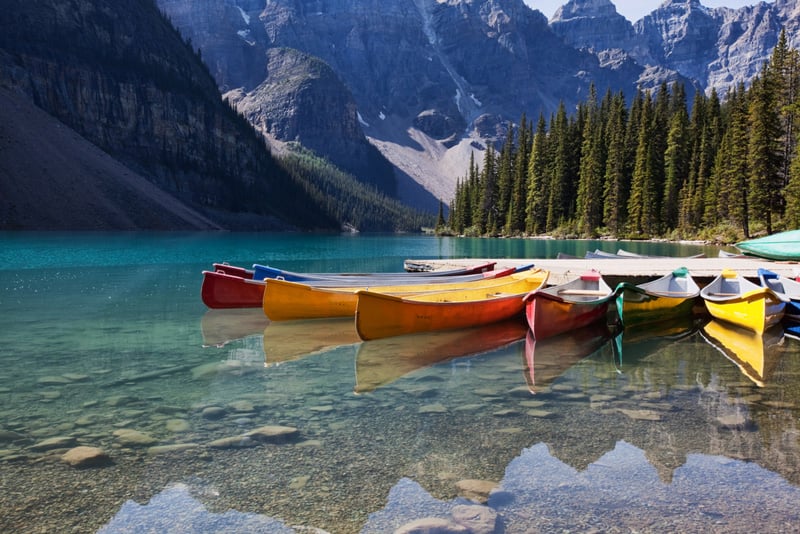
Canoes
How Big Is A Canoe?
Canoes come in a variety of sizes and materials. There are one-person (aka solo) canoes as well as tandem (two-person) canoes. There are recreational (beginner) canoes, as well as intermediate and advanced canoes. Some canoes are even designed specifically for rivers with white water rapids.
Canoes average between 16′ and 17′ in length. Longer canoes, once you get them up to speed, are easier to paddle and are a good choice for long distances. Conversely, shorter canoes are easier to transport and move around out of the water. These canoes can also get into places that longer canoes won’t fit, such as narrow channels.
As far as width goes, the wider the canoe, the more wind resistance and the more difficult it is to paddle. However, wider boats are also less “tippy”.
Canoe Bottoms
- Flat bottom canoes, which includes most recreational canoes, turn easily in the water, but can be slow when loaded with people and gear.
- Rounded bottom canoes are designed for speed and efficiency in the water and are found in many specialized canoes. These canoes are also slow to tip over and a good choice for rough waters.
- Canoes with a shallow arch bottom are a good compromise between flat bottom and rounded canoes. These canoes are more efficient in the water than flat bottom canoes.
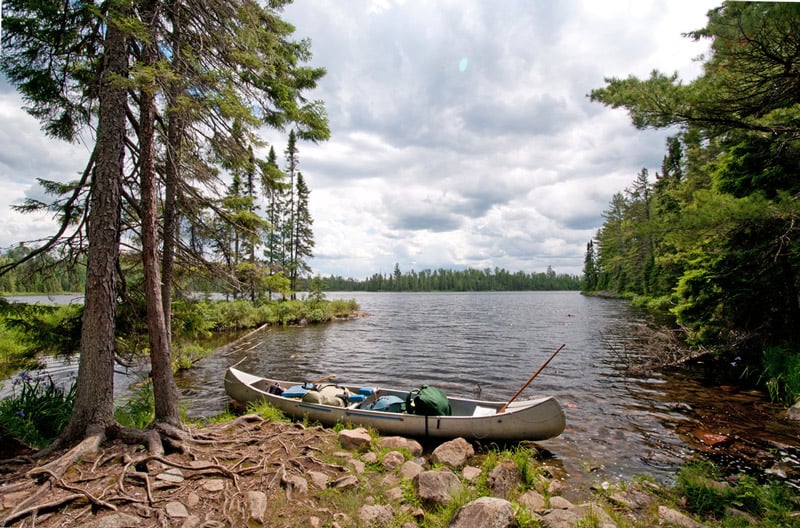
Canoe Types
Recreational Canoes
This is the type of canoe that most weekend or vacation paddling enthusiasts use. They can be made from aluminum or plastic, are very durable and can be left outside in the elements year round without damage. These are the type of canoes you’ll see for rent at summer resorts or on display at big box sporting goods stores.
Advantages to recreational canoes include being affordable, widely available and versatile as well as durable. They adapt to a variety of uses, from sightseeing to fishing. However, recreational canoes usually have few amenities and are strictly “bare bones” and they are generally slower to respond and less agile than other types of canoes.
Advanced/Touring Canoes
Advanced canoes (aka touring canoes), while generally more expensive, are lighter and offer more amenities for comfort and convenience than recreational canoes. They can also easily handle more gear than a recreational canoe.
This type of canoe is usually only available from a specialty paddle sports store or by special order from the big box store. Advanced canoes are a good choice for canoe enthusiasts who enjoy river journeys longer than a few hours and those who like to fish or bird watch from their canoe.
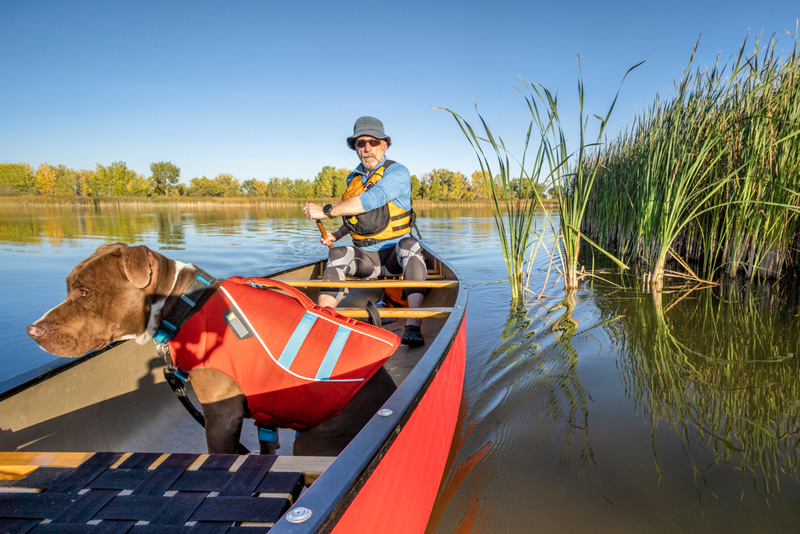
Whitewater Canoes
As the name implies, whitewater canoes are designed to glide through the roughest water the river has to offer. This type of canoe has higher sides to prevent water from sloshing into the canoe as well as flatter bottoms to allow the canoe to turn more easily. Whitewater canoes also have more “rocker”, the curvature from end to end, for better maneuverability.
Since whitewater canoers generally kneel rather than sit while paddling, these canoes have “seats” that are designed to accommodate that kneeling position. Like advanced canoes, this type of canoe is only available from specialty paddling stores.
Canoe Materials
Canoes are made from a variety of materials. Think about weight, strength and cost when you choose the material of your canoe.
- Aluminum is the typical material for most oder versions. These canoes are heavier than some modern materials, but are sturdy and durable. Aluminum canoes, however, tend to dent easily and can be noisy.
- Polyethylene foam canoes are lightweight, durable, responsive and float even when they are full of water.
- Fiberglass canoes, made from layers of woven fabric bonded together with polyester resin, glide easily in the water and are a good choice for recreational canoes.
- Kevlar canoes are stronger than fiberglass ones and considerably lighter. They are great for a long journey, but can be expensive.
- Wood canoes are the earliest version. They are easy to repair and can last more than a lifetime. The laborious construction makes these canoes expensive, but they are extremely durable.
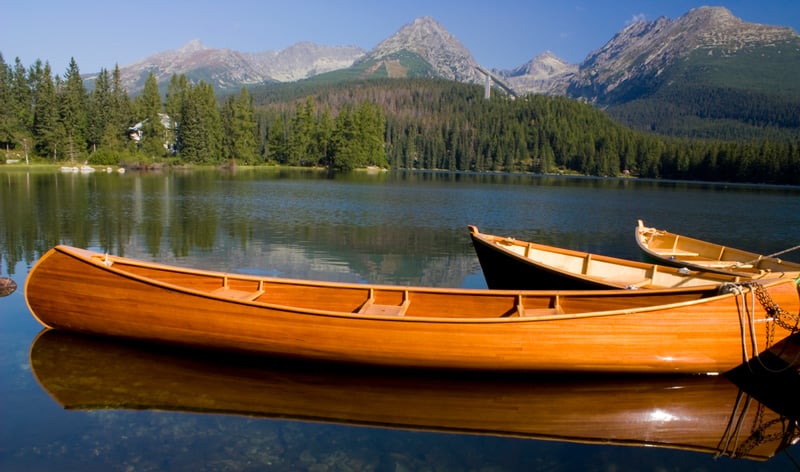
Canoe Amenities
In general, the more expensive the canoe, the more amenities it will have. Just a few to consider include…
- Seats — Most canoes have two seats, although there are a number of solo canoes. Seats can be cane, woven plastic or molded plastic. Cane seats dry quickly, look stylish and are very comfortable. However, they require more maintenance than other types of seats. Woven plastic allow water to drain away from your body, but can be hot and uncomfortable for a long journey. Molded plastic seats come in bench-style and body-style. They don’t allow air to circulate around the seat, so water won’t dry as quickly.
- Thwarts — Thwarts are the cross pieces that brace the sides of the canoe and provide stability and shape to the canoe. These can be made of wood, aluminum or fiberglass. They also provide “handles” to carry the canoe in and out of the river. Look for good balance.
- Gunwales — Gunwales (pronounced “gun-nels”) are the side rails that surround the upper edge of the canoe. These can be made of wood, aluminum or vinyl. Look for smooth gunwales that won’t hurt your hands or your paddles as well as good construction, as this part of the canoe gets a lot of wear. Wooden gunwales are attractive, but require regular maintenance. Vinyl is the least expensive, while aluminum is durable, but can be noisy when your paddle hits the side of the canoe.
- Storage — Higher end canoes often have under-seat canvas compartments for gear that are secured to the seat as well as mesh pouches on the sides of the canoes for extra paddles, etc.
- Paddles — Paddles for a canoe typically come with a single blade. In order to remain straight, the paddler must switch from one side of the body to the other and perform a J-stroke.
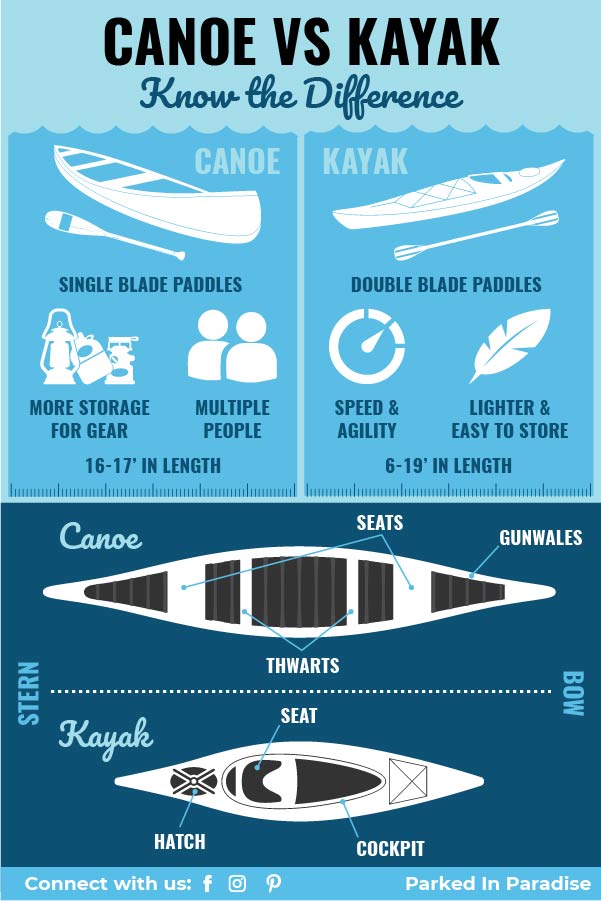
Kayaks
How Big Is A Kayak?
Kayaks are much more varied in size than canoes. Kayaks average between 6′ and 19′ in length. Longer kayaks glide and handle better in the water. They also offer more storage space for overnight gear. Wider kayaks tend to be more stable, but narrower kayaks will go faster in the water.
Kayaks with deeper hulls offer more legroom and more storage space. However, shallower kayaks are more stable and less affected by the wind.
Types of Kayaks
There are two main categories in kayaks–flat water and white water. In both categories, there are one-person and two-person canoes and sit-in and sit-on-top kayaks.
- Sit in kayaks, as the name implies, have a cockpit where you sit with your head and shoulders out of the kayak.
- Sit-on-top kayaks don’t have the cockpit. You sit in a seat atop the kayak. These are best for fishing, since you can see further in the water and have access to your gear, but generally provide a wetter ride.
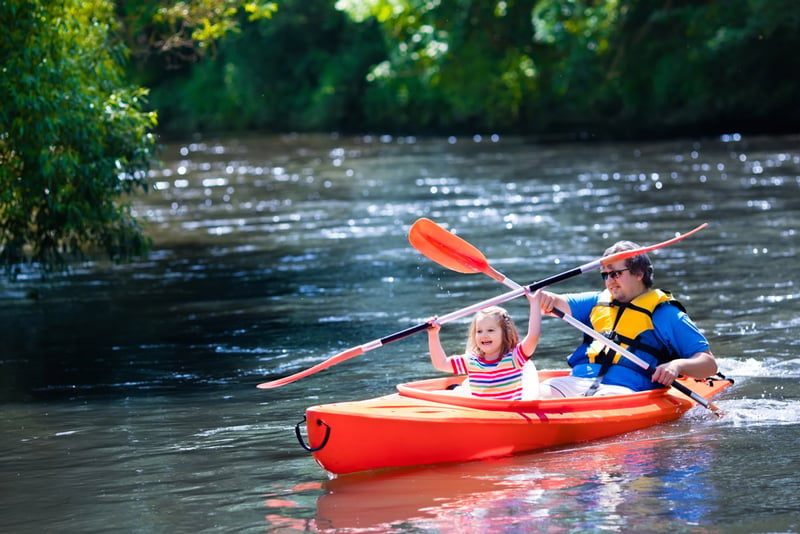
Recreational Kayaks
Recreational kayaks are designed for the casual kayaking enthusiasts and are usually 10 feet or less in length, shorter than most touring kayaks.
Most recreational kayaks have a cockpit and are generally shorter than touring kayaks. This makes them less fast and less able to track well (move in a straight line) than touring kayaks. However, recreational kayaks are affordable, stable, and easy to get in and out of. There are also great 2-person options for paddling with kids.
Touring Kayaks
Touring kayaks are advanced kayaks for longer journeys and more serious kayakers. These kayaks are generally longer (12′ or more) and have smaller cockpits. They tend to be narrower than recreational kayaks and are generally faster. They are have more storage space for gear.
Touring kayaks are usually more expensive then recreational kayaks and are available only via specialty paddling stores.
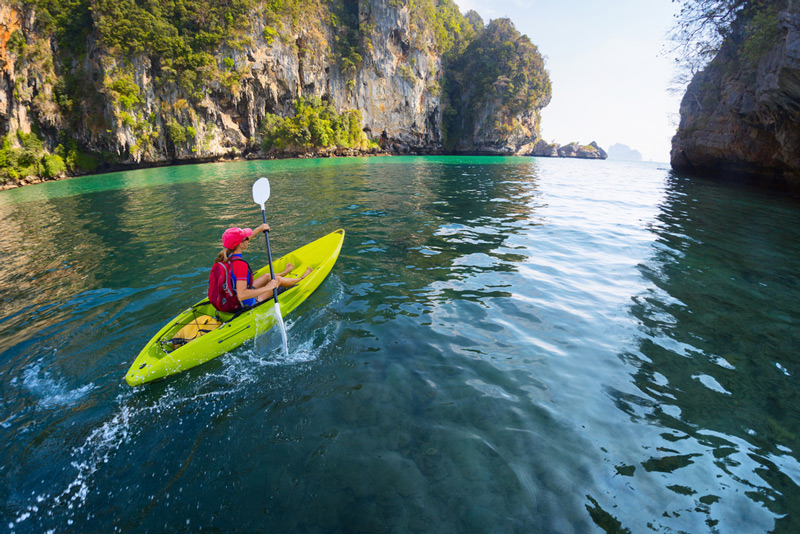
Inflatable Kayaks
Inflatable kayaks are relatively inexpensive and easy to store, but are not for the serious kayak enthusiast. While this type of kayak is lightweight, it tracks poorly and can be easily punctured and deflated.
Peddling Kayaks
Unlike most kayaks, peddling kayaks are propelled by using your feet rather than your arms. This makes them great for people with shoulder and back issues as well as fishing enthusiasts who need their hands free for managing their fishing gear.
The only downside to this type of kayak is the price. They tend to be significantly more expensive than other types of kayaks.
Whitewater Kayaks
Whitewater kayaks are distinctly different from flat water kayaks. They are shorter, usually between 5′ and 8′. The shorter kayaks are designed for doing tricks, such as in an area with waves and holes. The longer ones are more comfortable and better suited for several-hour journeys.
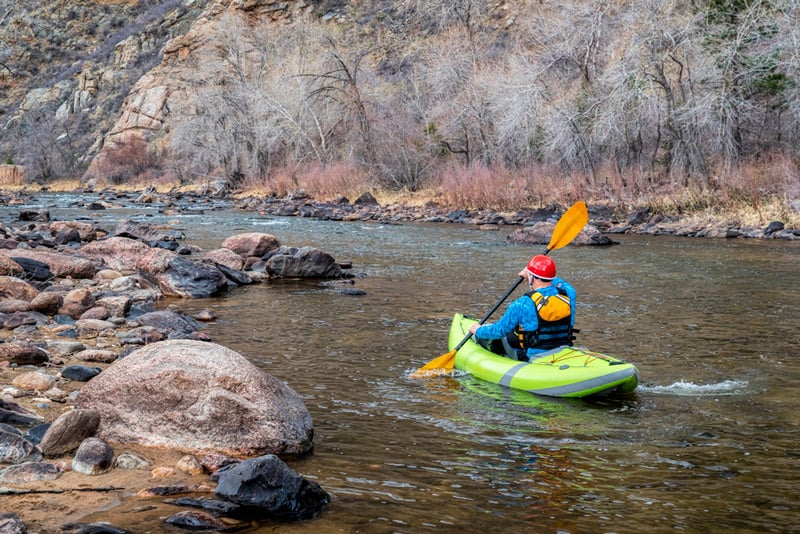
Kayak Materials
Like canoes, kayaks are made from a variety of materials. You can find kayaks made from polyethylene plastic, ABC plastic and composite materials.
- Polyethylene kayaks are the heaviest of the three materials, and, therefore, are somewhat harder to load and unload, especially by yourself. However, this type of kayak is the least expensive on the market. Plastic kayaks need to be stored indoors, as UV rays will damage the kayak over time.
- ABC plastic kayaks are slightly more expensive, but are somewhat lighter and easier to handle.
- Fiberglass and carbon-fiber composite kayaks are extremely lightweight and handle well in the water. They also stand up well to the sun’s rays. These are the most preferred among serious kayakers. However, composite kayaks can pricey, and more easily damaged by an impact with rocks.
Kayak Amenities
Other things to consider when shopping for a kayak include…
- Seats — Seats are optional in kayaks and can run you another $100 or so. However, they can make a big difference in comfort if you plan on taking your kayak on a longer journey.
- Rudders — A kayak rudder drops down and is operated by a foot pedal. It can be useful in keeping you on course.
- Skegs — A skeg is a useful kayak accessory. This is a dropdown fin that provides extra stability if you encounter a side wind.
- Hatches — Hatches provide exterior access to storage. Most touring kayaks have two hatches, while recreational kayaks usually have only one. Some are padded and adjustable.
- Paddles — Kayak paddles have a blade on each end.
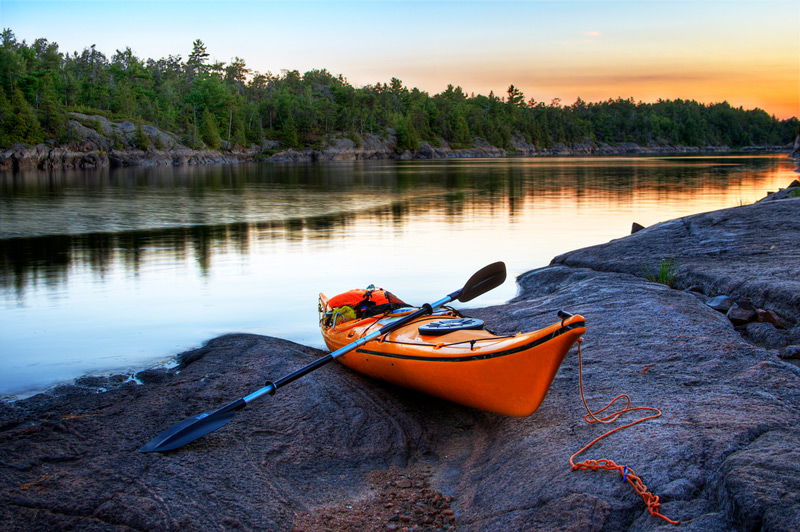
Canoes vs Kayaks: The Pros And Cons Of Each
So, which craft should you pick for your river adventures? There’s really no one right choice. There are pros and cons to both kayaks and canoes.
Durability
Durability really depends on the material you choose for your canoe or kayak. An aluminum canoe may suffer a few dents, but can last for decades. Conversely, some plastic kayaks will start to deteriorate in a few years if exposed to a lot of sunlight.
Versatility
For versatility, the canoe probably has the upper hand on the kayak. Most canoes can transport two people plus a reasonable amount of gear easily. Plus, they can adapt easily to river or (inland) lake paddling.
Speed
Kayaks are generally lighter than canoes, so you would expect them to be faster. The numbers support this. The average canoe can travel at about 2.6 knots or 3 mph. That compares to the average kayak at around 3 knots or 3.5 mph.
Of course, this number is dependent on the amount of energy you expend paddling and your experience in the craft. Still, we give a slight advantage to the kayak in speed.
Portages and Storage
Getting your canoe or kayak to and from the water is always a major consideration. Kayaks have the upper hand here, as most types can be easily handled by one person.
Canoes, especially aluminum canoes, are rather heavy and awkward to be carried by one person. In addition, canoes require a trailer or a truck, whereas kayaks can be stowed in the back of an SUV or on top of a car.
Comfort
Whereas most canoes are designed for two people, most kayaks are solo crafts. Comfort really depends on the type of canoe or kayak you choose. As we mentioned about cane canoe seats tend to be the most comfortable as well as the most expensive, and sit-in kayaks are generally more comfortable than sit-on-top.
Paddling is great way to get some exercise and enjoy the outdoors. Whether you choose to go canoeing or kayaking (or both), you’re sure to appreciate being out on the quiet water with birds, fish and other wild life. It’s a unique and special way to experience nature.

This Post Has 0 Comments